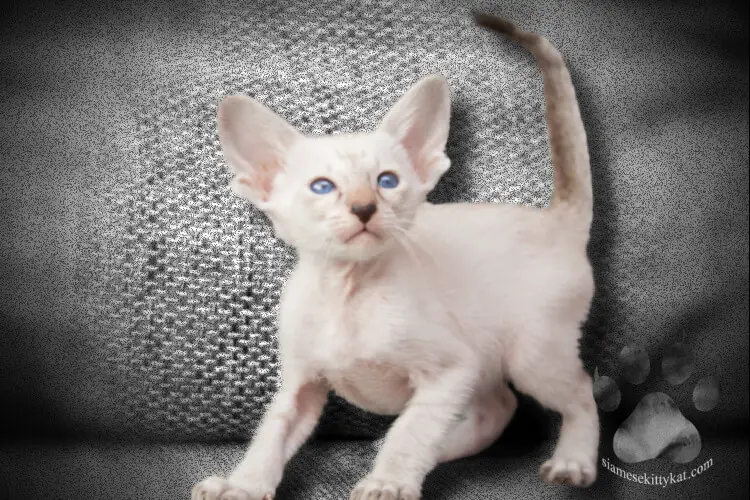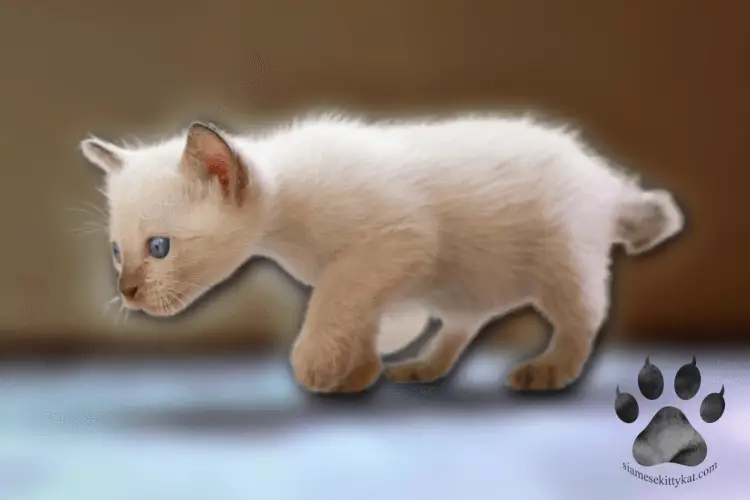It’s common knowledge that Siamese kittens are born pure white and develop their color in their first week of life. But some people believe they are born white and then change their color later. This article will look at the facts and fiction of this belief and determine whether or not they are born white.
Do Siamese kittens start white?
Siamese kittens are born white. Pure white. Why? Because their mother’s womb is impossibly warm!
The point gene will determine which part of a cat’s body will turn out to be colored. This gene produces the enzyme needed to produce pigment. Unless the gene is exposed to temperatures above 98 °F, the cells don’t make any more pigment.
Unlike other cats, Siamese cats do not develop any color in the warmer areas of their body, such as their necks and bellies. Instead, their point colors will be darker in cooler areas, like on their face and legs.
In some warmer climates, fur on these points will be lighter.
Since overweight cats can be heavier than others, they may appear darker from increased pigment in their body. Anything that may change the internal body temperature of your pet cat, such as when a sick cat has an abnormally high fever, can change its coat color!
How do you tell what color a Siamese kitten will be?
When it comes to Siamese kittens, there are a few things to look for to determine their color.
For starters, Siamese kittens are born white, and their color darkens as they mature. So, if you are looking at a Siamese kitten less than 6 weeks old, it is likely that it will be white. However, as they grow older, you will see hints of color around their eyes, ears, and tail.
The most common colors for Siamese kittens are seal point, blue point, chocolate point, and lilac points. The points are the darker colored areas on the face, ears, legs, and tail.
Seal point Siamese kittens have seal brown points. Blue point Siamese kittens have grayish-blue points. Chocolate point Siamese kittens have warm cinnamon and milk chocolate points. Lilac point Siamese kittens have pinkish-grey points.
Do white Siamese kittens stay white?
There are a few things to consider when determining whether or not a white Siamese kitten will stay white.
First, it is essential to know that the Siamese breed is prone to having a genetic mutation that causes their fur to darken as they age. This means that even if a white Siamese kitten is born, there is a chance that its fur will eventually darken to a cream or light brown color.
Secondly, it is also essential to consider the environment in which the kitten will be raised. If the kitten is raised in a home with a lot of natural light, their fur bleaches and becomes lighter over time. Conversely, their fur may become darker if the kitten is raised in a dim or dark environment.
Lastly, it is essential to note that diet can also affect fur color. If a kitten is fed a diet high in protein, its fur may become darker. Conversely, their fur may become lighter if a kitten is fed a diet low in protein.
How do you tell if a white kitten is Siamese?

There are a few ways to tell if a white kitten is Siamese.
- Look at the kitten’s face. Siamese kittens have distinctive facial features such as large, almond-shaped eyes, pointed ears, and long, slender noses. They have a wedge-shaped head.
Siamese kittens have very distinctive blue eyes, so if you see a white kitten with blue eyes, it’s probably a Siamese.
- Look at the kitten’s body. Siamese kittens have long, slender bodies and legs, with long tapering tails.
- Look at the kitten’s coat. Siamese kittens have a very fine, silky coat that is usually white with dark points (usually seal point, but can also be a chocolate point, blue point, or lilac point).
- Listen to its unique vocalizations. Siamese tends to meow in a high-pitched, trilling, distinctive voice. If you hear a white kitten making this type of noise, it is likely a Siamese.
What kittens are born white?
- Khao Manee
| Place of origin | Thailand |
| Date of origin | 14th century |
| Breed registries | GCCF, TICA |
| Weight range | 6-12lb (2.5-5.5kg) |
| Grooming | Weekly |
| Colors and patterns | White only. |
Khao Manee is a breed native to Thailand. These royal cats of Thailand were once considered the “white jewels.” In the 14th century, this pure white cat was described as having “eyes of clear mercury.” Cat fanciers started raising them throughout the years to preserve their unique characteristics: their shiny white coats. In 2013, the International Cat Association or TICA granted the Khao Manee the “Advanced New Breed” status.
This particular breed is very friendly in nature and loves being in its owner’s company, whether it be playing with them or just visiting.
- Oriental-Foreign White
| Place of origin | UK |
| Date of origin | 1950s |
| Breed registries | CFA, FIFe, GCCF, TICA |
| Weight range | 9-14lb (4-6.5kg) |
| Grooming | Weekly |
| Colors and patterns | White only. |
Oriental-Foreign White is a breed produced by crossing the short-haired white cat with a Siamese. The resulting breed had the long, slender lines of the Siamese. Throughout the years, foreign white cats have acquired distinctive physical traits and personalities while featuring characteristics of their Oriental ancestors.
The Oriental-Foreign White is very devoted to family life. It combines all of the social characteristics of its Oriental ancestors and many others alongside its striking good looks.
Many blue-eyed white cats suffer from deafness, but because of selective breeding, no such problem exists in this breed.
- Persian-Chinchilla
| Place of origin | UK |
| Date of origin | 1880s |
| Breed registries | CFA, FIFe, GCCF, TICA |
| Weight range | 8-15lb (3.5-7kg) |
| Grooming | Daily |
| Colors and patterns | White, tipped with black |
The Chinchillas were first introduced in the 1880s. It was not until the 1960s that James Bond films became popular and gave this cat fame. Chinchilla has a shimmering, silvery-white coat speckled with black tips. With black outlining around the eyes, it looks perky as though wearing makeup.
Chinchillas are friendly but may bite if you get too close or startle them.
- Persian-Shaded Silver
| Place of origin | UK |
| Date of origin | 1880s |
| Breed registries | CFA, FIFe, GCCF, TICA |
| Weight range | 8-15lb (3.5-7kg) |
| Grooming | Daily |
| Colors and patterns | White with black tipping |
This cat is often referred to as silver, but it’s only distantly related to the Chinchilla. The two breeds have very similar markings, with a white coat that looks like it has been tipped on the ends of the hairs with a darker hue.
The main difference is that in the Shaded Silver, they have a darker coat. The Shaded Silver has a dog-like personality since they tend to follow around their owners for attention.
- Turkish Van
| Place of origin | Turkey/UK (modern breed) |
| Date of origin | Pre-1700 |
| Breed registries | FIFe, TICA, CFA, ACFA, GCCF, ACF, WCF, NZCF |
| Weight range | 7-19lb (3-8.5kg) |
| Grooming | 2-3 times a week |
| Colors and patterns | White with dark colors on head and tail. |
In Turkey, indigenous people have long had a tradition of referring to white cats that have one eye with an odd color as “the van cat.” Coat color is a van, or chalk white in appearance with dark red-orange (auburn) colored fur at the base of the tail and lighter orange-red blazes over the skull.
Eye colors of Turkish Van include blue, odd-eyed, or yellow-amber, though this later may fade with age. Eyes are moderately large, wide-set, oval-almond shaped.
They are known as swimming cats for their love of water.
Turkish Van cats remain unique when it comes to their high energy needs and the many attributes that make them desirable as house cats. These are highly energetic breeds that can be described as “dog-like” with their highly active nature – making them suitable for play and entertainment. All of these qualities make the breed a great addition to any family because they have the ability without fail to keep us guessing when it comes to what they will do next! They are always on the go, but if you want your new feline friend to settle down for a moment and enjoy some cuddling time together, you might be surprised by how much Turkish Vans love taking naps like other pets.
- Turkish Vankedisi
| Place of origin | Eastern Turkey |
| Date of origin | Pre-1700 |
| Breed registries | GCCF |
| Weight range | 7-19lb (3-8.5kg) |
| Grooming | 2-3 times a week |
| Colors and patterns | Pure white only. |
The Turkish Vankedisi cat symbolizes wild beauty in its native Turkey. Most people would say it’s the perfect pet! The Turkish Vandekisi has a silky snow-white coat. This cat is famous for its good looks, but not just that; the Vandekisi is also known for its great physique.
Like many other white-colored cats, Turkish Vankedisi also comes with the issue of probable deafness. That doesn’t stop these cats from being strong and active.
Its pleasing temperament makes this breed an affectionate companion and energetic playmate! They have a special affinity for babies and young children, to whom they tend to display loving kindness.
- Birman
| Place of origin | Burma (Myanmar) |
| Date of origin | 1960s |
| Breed registries | TICA, CFA, ACFA, CFF, FIFe, NZCF, CCA, WCF, GCCF, ACF |
| Weight range | 10-18 lb (4.5-8 kg) |
| Grooming | Daily |
| Colors and patterns | Pure white. |
The Birmans are white cats that possess blue eyes. Birmans are a traditional cat breed that came from the Asian country of Burma. The first Birman cats arrived in England in the 1960s, and they immediately took America by storm when they were recognized by the CFA in 1967. Birmans entered the top 10 popular cat breeds in 1999.
Birman’s eyes are large and associated with deep vivid blue resembling sapphires. They have a distinctive look. They have a look and feel of a Siamese but with thicker bones and a rounder face.
Birman cats have a lovable temperament and are revered for their loyalty. They like to follow people around, preferring to be near when not being carried from place to place! On top of that, Birmans are playful, friendly, and calm.
Additional Information

Cats need pet-safe sunscreen applied to those areas where they are most susceptible to burning.
In this article, I hope I have been able to answer the question of whether Siamese kittens are born white. It is always exciting when I get an interesting question from our readers, and I hope I have been able to help. If you have any more questions about Siamese kittens, I would love to hear from you!
Get your FREE Siamese Cat 2025 Printable Calendar

